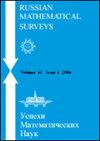四面体方程:代数、拓扑学和可积性
IF 2.1
4区 数学
Q1 MATHEMATICS
引用次数: 9
摘要
Zamolodchikov四面体方程几乎继承了Yang-Baxter方程所涉及的所有结构和主题的丰富性。同时,这种过渡象征着问题的级数的增长,从杨-巴克斯特方程到局部杨-巴克斯特方程,从李代数到2-李代数,从普通结点到2-结点。这些转换在几个例子中被遵循,并且还讨论了四面体方程在三维Ising模型的可积性的长期问题中的表现,以及神经网络理论的相关模型:二维晶格上的Hopfield模型。参考书目:82种。本文章由计算机程序翻译,如有差异,请以英文原文为准。
Tetrahedron equation: algebra, topology, and integrability
The Zamolodchikov tetrahedron equation inherits almost all the richness of structures and topics in which the Yang–Baxter equation is involved. At the same time, this transition symbolizes the growth of the order of the problem, the step from the Yang–Baxter equation to the local Yang–Baxter equation, from the Lie algebra to the 2-Lie algebra, from ordinary knots in to 2-knots in . These transitions are followed in several examples, and there are also discussions of the manifestation of the tetrahedron equation in the long-standing question of integrability of the three-dimensional Ising model and a related model of neural network theory: the Hopfield model on a two-dimensional lattice. Bibliography: 82 titles.
求助全文
通过发布文献求助,成功后即可免费获取论文全文。
去求助
来源期刊
CiteScore
1.70
自引率
0.00%
发文量
12
审稿时长
>12 weeks
期刊介绍:
Russian Mathematical Surveys is a high-prestige journal covering a wide area of mathematics. The Russian original is rigorously refereed in Russia and the translations are carefully scrutinised and edited by the London Mathematical Society. The survey articles on current trends in mathematics are generally written by leading experts in the field at the request of the Editorial Board.

 求助内容:
求助内容: 应助结果提醒方式:
应助结果提醒方式:


